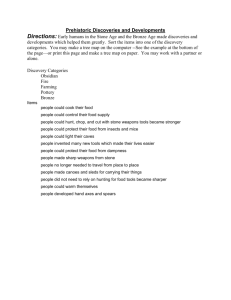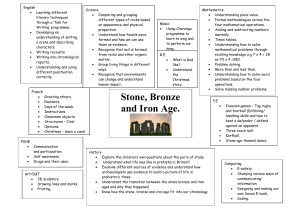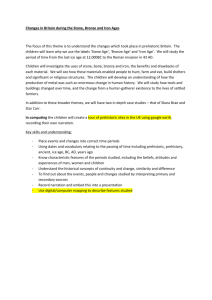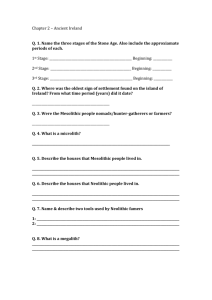The Story of Stone Age
advertisement
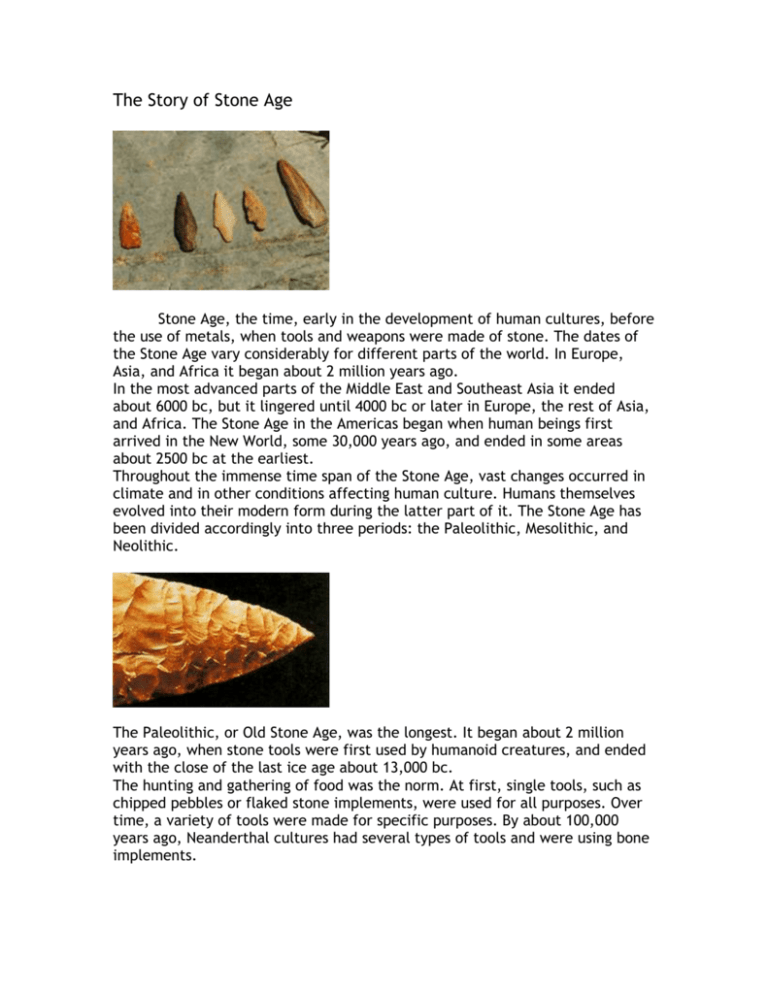
The Story of Stone Age Stone Age, the time, early in the development of human cultures, before the use of metals, when tools and weapons were made of stone. The dates of the Stone Age vary considerably for different parts of the world. In Europe, Asia, and Africa it began about 2 million years ago. In the most advanced parts of the Middle East and Southeast Asia it ended about 6000 bc, but it lingered until 4000 bc or later in Europe, the rest of Asia, and Africa. The Stone Age in the Americas began when human beings first arrived in the New World, some 30,000 years ago, and ended in some areas about 2500 bc at the earliest. Throughout the immense time span of the Stone Age, vast changes occurred in climate and in other conditions affecting human culture. Humans themselves evolved into their modern form during the latter part of it. The Stone Age has been divided accordingly into three periods: the Paleolithic, Mesolithic, and Neolithic. The Paleolithic, or Old Stone Age, was the longest. It began about 2 million years ago, when stone tools were first used by humanoid creatures, and ended with the close of the last ice age about 13,000 bc. The hunting and gathering of food was the norm. At first, single tools, such as chipped pebbles or flaked stone implements, were used for all purposes. Over time, a variety of tools were made for specific purposes. By about 100,000 years ago, Neanderthal cultures had several types of tools and were using bone implements. At the end of the Paleolithic period, modern humans (Homo sapiens) made such specialized tools as needles and harpoons. In the Cro-Magnon caves of Europe, wall paintings and evidence of both religious cults and possible social stratification point to the complexity of the cultures. After 13,000 bc more clement weather patterns resulted in the greater availability of food. In tropical and temperate forest regions, Paleolithic tools, still chipped, were adapted to the new conditions. This period is known as the Mesolithic, or Middle Stone Age. In both the Middle East and in Mesoamerica, however, agricultural villages had begun to develop by 8000 bc. This is known as the Neolithic period, or New Stone Age. Stone tools became highly polished and varied. By 6000 bc pottery appeared in the ancient Middle East, and copper was used for the first time in some regions. In other regions, the Neolithic arrived much later. The Stoy of Bronze Age Bronze Age, the time in the development of any human culture, before the introduction of iron, when most tools and weapons were made of bronze. Chronologically, the term is of strictly local value, for bronze came into use, and was again replaced by iron, at different times in different parts of the world. It generally succeeds a culture's Copper Age. Archaeological discoveries since 1960 have upset traditional theories concerning the origins of copper and bronze technologies. It had been thought that the use of bronze had originated in the Middle East, but discoveries near Ban Chiang, Thailand, indicate that bronze technology was known there as early as 4500 bc. This preceded the working of bronze in the Middle East by several hundred years. Bronze objects have been found in Asia Minor that date from before 3000 bc. At first this alloy was used sparingly, mostly for decorative purposes; the tin needed to make it was not available in the region. Regular imports of tin from Cornwall in Britain during the 2d millennium bc, however, made possible wider use of bronze in the Middle East, and it was eventually utilized for tools and weapons. Raw copper was being pounded into tools and ornaments as early as 10,000 bc. Later discoveries at Rudna Glava in Yugoslavia have shown that copper was in use there in 4000 bc, although bronze was not made at that time. By 3000 bc bronze began to be used in Greece. In China the Bronze Age did not begin until 1800 bc. The pre-Columbian civilizations of the Americas had no bronze technology until about ad 1000. The Bronze Age in the Middle East and the eastern Mediterranean has been divided into three phases early, middle, and late. The early phase is characterized by increased use of the metal, from the sporadic to the common. It was the time of the Sumerian civilization and the rise of Akkad to prominence in Mesopotamia; it also generated the spectacular treasures of Troy. Babylon reached its height of glory during the middle Bronze Age. Minoan Crete and Mycenaean Greece were major late-Bronze-Age civilizations. The Bronze Age there ended about 1200 bc, after which iron technology became common. The Story of Iron Age Iron Age, marks the period of development of TECHNOLOGY, when the working of iron came into general use, replacing bronze as the basic material for implements and weapons. It is the last stage of the archaelogical sequence known as the three-age system (Stone Age, Bronze Age, & Iron Age). Chronologically, the term is only of local value because iron took the place of bronze at different times in different cultures. The major technical advance of the early Greek period was the widespread use of iron. Furnaces were developed that could reach the high melting temperature of that metal. Iron technology had spread throughout the classical world by about 500 BC. Early steels were discovered by adding small amounts of carbon to iron as it was hammered over a charcoal fire. Mining became well developed and included the use of pumps to keep mines from flooding. Metalware was used for pots and dishes, sometimes with unforeseen disastrous results such as lead poisoning. Among the greatest Roman works were the large aqueducts that carried water for hundreds of miles, roads that spanned the empire, and public sewer systems. Advances in building construction led to the widespread use of the arch by the Romans and to the invention of durable cements and concretes for structures that have survived to the present. Technology also advanced weaponry with the development of catapults, better swords, and body armor.
